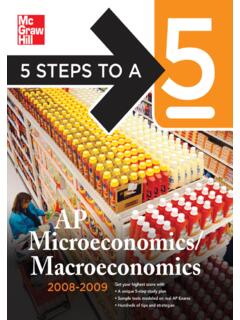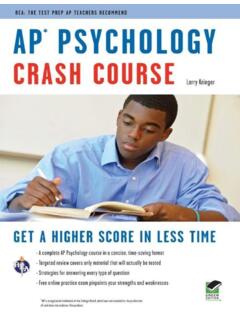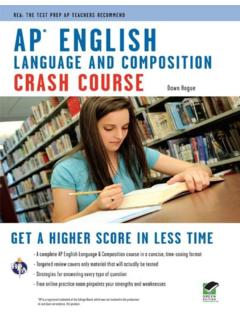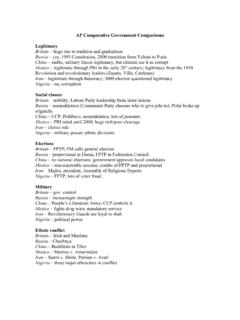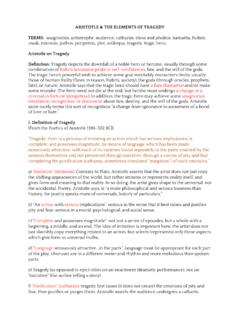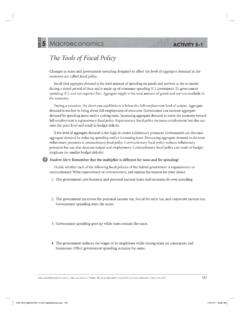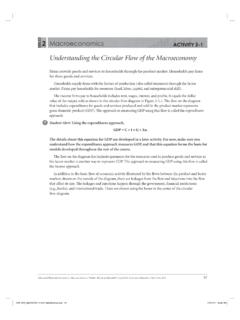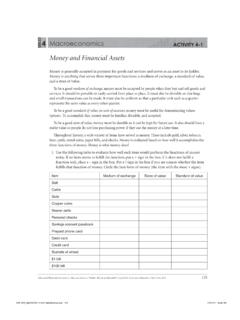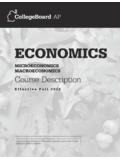Transcription of AP Macroeconomics Crash Course (Advanced …
1 Planet Friendly Publishing Made in the United States Printed on Recycled Paper Text: 10% Cover: 10%Learn more: REA we re committed to producing books in an earth-friendly manner and to helping our customersmake greener books in the United States ensures compliance with strict environmental laws andeliminates the need for international freight shipping, a major contributor to global air printing on recycled paper helps minimize our consumption of trees, water and fossil fuels. Thisbook was printed on paper made with 10% post-consumer waste. According to EnvironmentalDefense s Paper Calculator, by using this innovative paper instead of conventional papers, we achievedthe following environmental benefits:Courier Corporation, the manufacturer of this book, owns the Green Edition Saved: 4 Air Emissions Eliminated: 697 pounds Water Saved: 673 gallons Solid Waste Eliminated: 205 poundsFor more information on our environmental practices, please visit us online at & Education Association 61 Ethel Road West Piscataway, New Jersey 08854 E-mail: Macroeconomics Crash COURSEC opyright 2012 by Research & Education Association, Inc.
2 All rights reserved. No part of this bookmay be reproduced in any form without permission of the in the United States of AmericaLibrary of Congress Control Number 20119319509780738669656 LIMIT OF LIABILITY/DISCLAIMER OF WARRANTY: Publication of this work is for the purpose oftest preparation and related use and subjects as set forth herein. While every effort has been made toachieve a work of high quality, neither Research & Education Association, Inc., nor the authors and othercontributors of this work guarantee the accuracy or completeness of or assume any liability in connectionwith the information and opinions contained herein and in REA s companion online materials. REA andthe authors and other contributors shall in no event be liable for any personal injury, property or otherdamages of any nature whatsoever, whether special, indirect, consequential or compensatory, directly orindirectly resulting from the publication, use or reliance upon this trademarks cited in this publication are the property of their respective is a registered trademark of Research & Education Association, Macroeconomics Crash COURSEA ccess Your ExamTable of ContentsTitle PageCopyright PageAP Macroeconomics Crash COURSEABOUT THIS BOOKABOUT OUR AUTHORACKNOWLEDGMENTSPART I - INTRODUCTIONC hapter 1 - Keys for Success on the AP Macroeconomics ExamChapter 2 - Key Formulas and Definitions for AP MacroeconomicsPART II - BASIC economic CONCEPTSC hapter 3 - Basic economic ConceptsChapter 4 - Supply, Demand.
3 And Equilibrium in Product MarketsPART III - MEASUREMENT OF economic PERFORMANCEC hapter 5 - National Income AccountsChapter 6 - Inflation Measurement and AdjustmentChapter 7 - UnemploymentPART IV - NATIONAL INCOME AND PRICE DETERMINATIONC hapter 8 - Aggregate DemandChapter 9 - Aggregate SupplyChapter 10 - Macroeconomic Equilibrium in the AD/AS ModelPART V - FINANCIAL SECTORC hapter 11 - Money, Banking, and Financial MarketsChapter 12 - Central Bank and Control of the Money SupplyPART VI - MACROECONOMIC POLICIES, INFLATION, AND UNEMPLOYMENTC hapter 13 - Fiscal and Monetary PoliciesChapter 14 - Inflation and UnemploymentPART VII - economic GROWTH AND PRODUCTIVITYC hapter 15 - Sources of economic Growth and ProductivityPART VIII - OPEN ECONOMY: INTERNATIONAL TRADE AND FINANCEC hapter 16 - Balance of Payments AccountsChapter 17 - Foreign Exchange MarketPART IX - TEST-TAKING STRATEGIESC hapter 18 - Strategies for the Multiple-Choice QuestionsChapter 19 - Strategies for the Free-Response QuestionsEconomics GlossaryWelcome to REA s Crash Course for AP MacroeconomicsABOUT THIS BOOKREA s AP Macroeconomics Crash Course is the first book of its kind for the last-minute studier or anyAP student who wants a quick refresher on the Course .
4 The Crash Course is based on a careful analysisof the AP Macroeconomics Course Description outline and actual AP test questions released by theCollege by an AP teacher, our easy-to-read format gives students a Crash Course in Macroeconomics . Thisreview will prepare you for test day by focusing on important topics frequently seen on the APMacroeconomics other test preps, REA s AP Macroeconomics Crash Course gives you a review specificallyfocused on what you really need to study in order to ace the exam. The introduction discusses the keys forsuccess and includes a list of terms all AP Macroeconomics students must targeted review chapters are grouped by topics, offering you a concise way to learn all the importantideas, facts, and terms before exam day. The author gives you expert test-taking strategies to conquer themultiple-choice and free-response questions on the matter how or when you prepare for the AP exam, REA s AP Macroeconomics Crash Course willshow you how to study efficiently and strategically, so you can boost your score!
5 To check your test readiness for the AP Macroeconomics exam, either before or after studying this CrashCourse, take our online practice exam. To access your free practice exam, and follow the on-screen instructions. This true-to-format test featuresautomatic scoring of the multiple-choice questions and detailed explanations of all answers. Ourdiagnostic analysis will help you identify your strengths and weaknesses, so you ll be ready on exam day!Good luck on your AP Macroeconomics exam!ABOUT OUR AUTHORJ ason Welker s interest in economics began in the late 1990s, when, as a high school student studyingeconomics at an international school in Malaysia, he experienced firsthand the effects of the Asianfinancial crisis that saw the economies of Southeast Asia plunge into recession and trigger widespreadpolitical unrest. At university in Seattle, Jason once again witnessed the power that economics holds oversociety when the World Trade Organization s Seattle summit attracted tens of thousands of protesters,whose anger over globalization escalated into riots.
6 From these experiences, and with the inspirationprovided by his Intro to Economics professors, Jason decided he wanted to dedicate his studies tounderstanding the role economics plays in shaping human societies. His personal economics educationhas continued ever s international teaching career has taken him to schools in Thailand, China, and most recently toSwitzerland, where he is currently teaching advanced placement and International BaccalaureateEconomics at an international school in Zurich, the financial capital of addition to teaching economics to nearly 100 students from 40 countries each year, Jason writes a blogfor Economics students around the world which can be read He has also led workshops on technology in theEconomics classroom at AP Summer Institutes and at the National Center for Economics Educationconference in Washington, He has recently completed a textbook for the IB Economics curriculum,and is constantly developing and making available many other resources for Econ students through hiswebsite.
7 His latest venture, AP Macroeconomics Crash Course , provides students with a powerfulresource for use in preparation for their AP addition to our author, we would like to thank Larry B. Kling, Vice President, Editorial, for his overallguidance, which brought this publication to completion; Pam Weston, Publisher, for setting the qualitystandards for production and managing the publication to completion; Diane Goldschmidt, Senior Editor,for editorial project management; Alice Leonard and Kathleen Casey, Senior Editors, for preflighteditorial review; and Weymouth Design, for designing our would also like to extend special thanks to Tyson Smith of Iowa City West High School fortechnically reviewing the manuscript, Elizabeth Catafalmo for copyediting, Caroline Duffy forproofreading, and Kathy Caratozzolo of Caragraphics for typesetting this IINTRODUCTIONC hapter 1 Keys for Success on the AP Macroeconomics ExamThe subject of Macroeconomics is vast in content and at the university level it may be taught over the spanof several years of courses.
8 In fact, one could even major in a macroeconomic topic and pursue advanceddegrees within the field. You, on the other hand, are probably taking AP Macroeconomics as a one- orpossibly two-semester high school Course in the 11th or 12th how can a high school student be expected to learn all the content that may be consideredmacroeconomics and be prepared enough to score a respectable mark on the advanced placement exam?Rest assured, with a few crucial pieces of information and some important hints and tips, you can focusyour studies in and out of the classroom toward the most important concepts that are most likely to beaddressed on the AP Macro Crash Course , along with your Course textbook, your teacher, your classmates and countless onlineresources, is your single greatest key to success on the AP Macro exam. There is no shortage of resourcesin print and online for the high school economics student today. But with all the information out there, anda syllabus that spans seven units of macroeconomic study, how do you know what is the most importantmaterial to study for the AP Macro exam?
9 RELATIVE IMPORTANCE OF THE AP MACRO UNITSON THE EXAMWith all the information out there, how do you know in what areas to focus? One thing all AP Macrostudents should know as they progress through the Course and prepare for the exam is the relativeimportance of each of the units in the AP Macro exam is a two-part examination. The first part is a 60-question multiple-choice (MC) 60 questions come from the seven units of the AP Macro Course . Thankfully, the AP makes public theapproximate percentage of the 60 multiple-choice questions that will come from each of the sevensections of the Course . The breakdown is as follows: Unit 1: Basic economic Concepts, Supply, Demand, and Equilibrium (8 12 percent) Unit 2: Measurement of economic Performance (12 16 percent) Unit 3: National Income and Price Determination (10 15 percent) Unit 4: The Financial Sector (15 20 percent) Unit 5: Macroeconomic Policies, Inflation, and Unemployment (20 30 percent) Unit 6: economic Growth and Productivity (5 10 percent) Unit 7: Open Economy: International Trade and Finance (10 15 percent)With the approximate percentages of each unit s representation on the multiple-choice section of theexam, you can focus your exam studies appropriately.
10 For example, you can see above that the mostcommonly tested units are Unit 4 The Financial Sector, and Unit 5 Macroeconomic Policies. Thesetwo units together could make up as much as 50 percent of the 60 questions on the multiple-choice sectionof the you use this Crash Course to study, you will notice that the most heavily assessed units are given themost attention in this book. Units 4 and 5, for example, account for more than 60 pages. In this way, thenumber of pages dedicated to each unit in the Crash Course is roughly representative of the weight thatunit is given on the AP free-response question (FRQ) section of the exam includes three questions. The first question isalways a long FRQ, on which you are expected to spend approximately 30 minutes planning andanswering. The second and third questions are short FRQs, on which you are expected to spendapproximately 15 minutes planning and answering. The topics the FRQs cover could come from anysection of the syllabus, although there are certain topics that are more commonly tested than others, givingthe FRQ section some degree of predictability.
